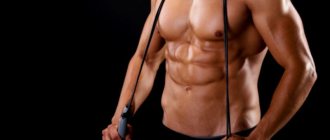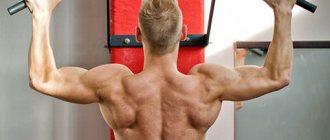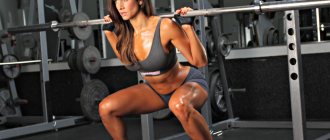You don't want to spend a lot of time in the gym, but you still want to become stronger, leaner, more resilient and just look good? It's possible that you're not getting the most out of your workouts.
There is a way that will help you train for just 30 minutes and still get super results , you will only need a few workouts a week if you maximize them.
- Denial of responsibility
- Get to the point
- Nutrition
- Let's go against the grain
- The perfect workout plan
- Remember
Get to the point
Whether you get permission or haven't tried to get it, start slowly to give your body a chance to get used to the stress and prevent you from getting sprains or other injuries.
You shouldn’t dive headfirst into the pool - this method is intended for people who are already training, but want to get better results, as well as train faster and spend less time on it. Here's how to do it.
It is better to train more intensely, but for a shorter period of time.
Limit your workouts to 30–40 minutes. Although many people follow the trend that if you want to get good results, you need to spend a lot of time in the gym, however, the truth is that after 30-40 minutes of exercise, the benefits are not that great. To stay active for long periods of time, you will have to reduce the intensity of your workouts, which means you will spend too much time doing them. It is better to train more intensely, but for a shorter period of time.
Benefits of working out at the gym
A wide variety of exercise machines will help you lose excess weight, strengthen all muscle groups and reduce the risk of various diseases.
Working out in the gym charges you with positive energy, as training together with other people creates the necessary atmosphere, motivates and improves your mood. In the gym you can not only pay attention to exercises, but also socialize.
Each gym has a professional trainer who will advise on the choice of exercise equipment, training program and nutrition.
Classes in the gym train endurance, teach you to overcome obstacles and go towards your goal, both in exercise and in everyday life.
Physical exercise strengthens the nervous system, the heart, regulates the functioning of the gastrointestinal tract, and lowers cholesterol levels.
Working out at the gym requires paying for a membership: this way, there will be less temptation to skip classes.
Nutrition
Protein
Many people don't pay attention to getting enough protein for muscle recovery. If you do the same, you will get very little out of your workout, since both cardio and strength training require a lot of protein to build muscle. I recommend whey or soy protein shakes.
Water
You should drink enough fluids per day. It takes several hours for the body to absorb water, so you should not drink it immediately before training. Drinking water regularly throughout the day should become your habit.
Carbohydrates
Although a low-carb diet can help you lose weight, carbohydrates are the body's main source of fuel. If you are doing intense workouts, then you need to consume carbohydrates, otherwise you will not have enough energy. If you make a smoothie, don't forget to add carbohydrates or a banana - a source of fiber and glycemic carbohydrates, which are needed for exercise.
Cocktail
Drink a shake before and after your workout. It is best to consume a protein/carbohydrate shake immediately before and then immediately after exercise. By drinking such a drink before training, you increase the flow of amino acids into the muscles, providing them with the necessary “building blocks,” so to speak. After a workout, the shake stimulates muscle growth. Also eat a small protein/carbohydrate meal 60-90 minutes after exercise.
Let's go against the grain
Slow rise
Many people pump their muscles this way: slowly lift the load and then sharply lower it. If you raise and lower it equally slowly, you will get the most benefit from the exercise. Let the rise and fall take you at least 5 seconds.
You should not get carried away and take on loads for which you are not yet prepared - this is ineffective.
Weight gain
When you start exercising, it is best to take light weights until you get into good physical shape. But as soon as you are ready, it is better to increase the weight. You should not get carried away and take on loads for which you are not yet prepared - this is ineffective. However, heavy weights with good preparation can give excellent results in a short time. The opinion that heavy weights are only for those who want to shape the relief is a common misconception.
One approach
Instead of doing 2-3 sets, as many people are used to doing, maximize efficiency by doing only one set, but with heavy weight as long as you can perform the exercise correctly. This method requires you to stop when you can no longer lift the barbell or have shaky hands when holding it.
Set of exercises
Instead of focusing on just one specific muscle, such as the biceps curl, you can maximize the time you spend working out by doing exercises that work multiple muscle groups at once. With just a few exercises you can tone your entire body.
Another benefit is that your muscles will work together the same way they do in real life, rather than working alone. Some compound exercises include squats, deadlifts, lunges, push-ups, bench press, pull-ups and more. Mobile training apps containing effective complexes can help you understand this problem.
Keep your balance
Instead of doing exercises where you sit or hold onto something, do ones that require you to balance , such as doing them standing or on one leg, or using Swiss ball exercises. These types of strength training allow you to work all your major muscles. This will make your body stronger and allow you to increase the intensity over time.
Don't stick to the same workout routine for too long.
Cardio is a must
Choose cardio exercises to suit your taste. You won't enjoy working out if you hate it. And you won't be able to devote much time to her. Choose only what you really enjoy: running, walking, swimming, cycling, hiking, rowing, etc. Once you're hooked, you'll be looking forward to your next workout, especially if you try out the convenience of modern gadgets for running and other sports.
Mix
Don't stick to the same workout routine for too long, or your body will get used to it, which won't benefit you. Change the type of strength training every few weeks. For cardio, it's better to do cross-country runs periodically than, say, just run on a treadmill every day.
Good form
For strength training, especially something like swimming, form is very important, as it is for other types of exercise. If you start your strength training by lifting small weights, you can get into the shape you need. It's good to have an experienced coach or mentor who is in excellent physical shape and can help you adapt at first. Never sacrifice your health for a heavier weight. For swimming, you should definitely consult a trainer who will help you acquire good physical fitness.
One mistake many people make is not resting between workouts.
Hills
If you start incorporating cardio workouts such as cycling or walking, try incorporating hill climbs (after the first month or two, go slowly). This will make you stronger and make your limited training time even more effective. Start small, and when you get used to it, increase the pace.
Scheme
One mistake many people make is not resting between workouts. This prevents your muscles from recovering and the exercises are not beneficial. It's better to do one pattern, then rest, then do the next one, it's more effective. This way you won't have to rest between exercises, but each of your muscle groups will be able to rest. It's good to alternate cardio workouts with strength training.
Training programs for girls in the gym
Power training
Barbell squats (strengthens thighs and buttocks):
- stand straight, feet shoulder-width apart;
- place the bar on your shoulders;
- squat, keeping your back straight;
- lean forward with your upper body and place your body weight on your heels;
- hold for a couple of seconds;
- return to the starting position;
Vertical pull-down (upper back strengthening):
- take the starting position, keep your back straight;
- spread your hands wide on the holder;
- pull the holder forcefully towards you;
- slowly return to the starting position;
Bench press (arm, shoulder and chest muscles):
- prepare the barbell;
- take a position on a bench;
- Place your hands wider than your shoulders;
- lower the bar to chest level;
- as you exhale, lift the barbell to the starting position;
Barbell row to the chin (muscles of the back, chest, arms and shoulder girdle):
- place the barbell on the floor;
- take with an overhand grip;
- straighten your back and hold the barbell at hip level, bend your arms slightly at the elbows;
- as you exhale, pull the barbell to your chin;
- hold for a few seconds;
- return to the starting position;
Crunches (press using a bench):
- take the starting position;
- tighten your abdominal muscles;
- as you exhale, lift your body and twist your back;
- pause for a second;
- lower as you inhale.
For weight loss in the gym
To effectively lose weight in the gym, you need to alternate between strength and aerobic exercise. The first visible changes can be obtained after just half a month of intensive training according to a properly designed program.
Barbell Squats using a barbell (15-20 reps, 2-3 sets):
- stand up straight;
- legs slightly wider than shoulders;
- place the bodybar on your shoulders and squeeze your shoulder blades together;
- sit down, leaning forward slightly;
- Shift your weight to your heels, tighten your abs;
- hold your breath at the top point;
- after rising, exhale;
Dumbbell row towards the waist (15-20 repetitions, 2-3 sets):
- rest your hand on a special stand;
- put your leg forward, move your pelvis back;
- as you exhale, raise your arm with the dumbbell up;
- while inhaling, lower the dumbbell down;
Lunges with dumbbells in hands (15-20 repetitions, 2-3 sets):
- take the dumbbells in your hands and take a step forward;
- lower yourself down, placing your thigh parallel to the floor;
- Place the other leg behind;
- push off with your front foot;
- return to the starting position;
Dumbbell flyes in a lying position (15-20 repetitions, 2-3 sets):
- sit on a bench and take dumbbells in your hands;
- lie down with dumbbells so that your head does not hang over the bench;
- lift the dumbbells in front of you at a right angle;
- while inhaling, spread the dumbbells to the sides;
- as you exhale, return your arms to their original position;
Arm extension on a block (15-20 repetitions, 2-3 sets):
- stand up straight;
- Take a short, straight handle with a straight grip;
- press your elbows to your body;
- place your feet in a straight line;
- bend your arms and lower the weight down, using your triceps;
Seated dumbbell or barbell press (15-20 repetitions, 2-3 sets):
- sit up straight, straighten your shoulders and squeeze your shoulder blades together;
- Bend your lower back slightly forward;
- as you exhale, lift the dumbbells to shoulder level;
- As you inhale, lower it down.
For gaining muscle mass
Train 3-4 times a week. The duration of the workout is at least 20 minutes, the emphasis is on strength exercises. To gain muscle mass, use heavy weights and fewer repetitions.
Start your workout with cardio and core stretching. Warm up your muscles and stretch your joints to avoid injury.
Workouts for gaining mass include basic exercises:
- deadlift with a barbell;
- squats with a barbell on the shoulders;
- leg press in the gym;
- lunges with dumbbells;
- Smith machine exercise;
- close grip barbell press;
- seated press;
- barbell pull to the chin;
- bench press;
- leg curls lying on a bench;
- standing and sitting calf workout.
To maintain physical fitness
Workouts to maintain physical fitness include exercises:
- Squats (20 reps);
- Raising the body (20 repetitions);
- Push-ups (20 repetitions);
- Lunges (20 repetitions on each leg);
- Deadlift (20 reps);
- Scissors (20 repetitions);
- Plank (minimum 15 seconds for the first time, increase over time to 2-5 minutes);
- Pelvic lift (20-40 repetitions);
- Swings (20 repetitions);
- Leg raises (20 repetitions).
The perfect workout plan
If you use all of these tips, your ideal workout plan would look something like this: 2-3 days of high-intensity strength training, followed by 2-3 days of intense cardio. You can only do 4 days if the exercises are sufficiently complete.
Strength training takes about 30-40 minutes if you do it without rest or with minimal intervals between circuits, if there are several of them. The circuit should work your entire body using compound exercises such as squats, deadlifts, pull-ups, etc. either standing or using a Swiss ball. You should increase the load by performing each set of exercises slowly (5 seconds up, 5 seconds down) until exhaustion, making sure you have sufficient training for this.
protein/carbohydrate meal It is also very important for both types of training to drink enough water.
Do your favorite cardio workouts. Gradually increase your set time and decrease your rest time. Sometimes include some hill climbing.










